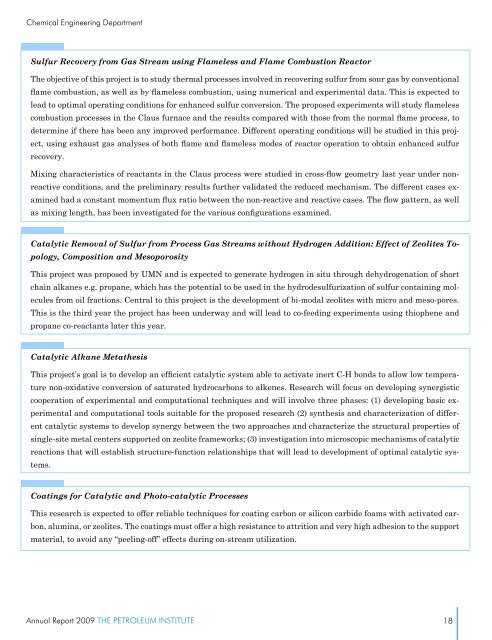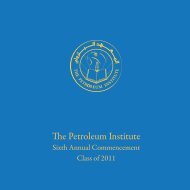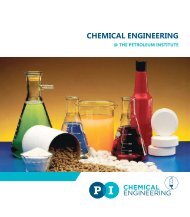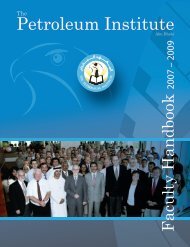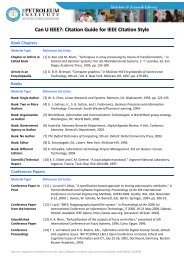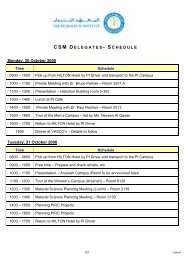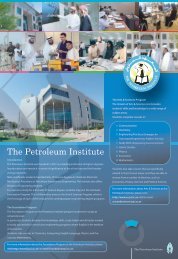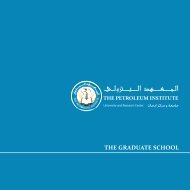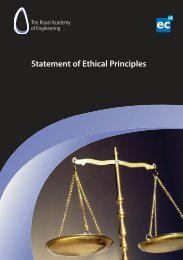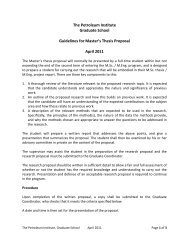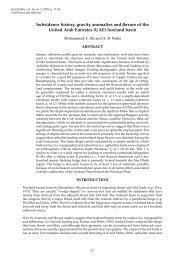The PI Annual Report 2009 - The Petroleum Institute
The PI Annual Report 2009 - The Petroleum Institute
The PI Annual Report 2009 - The Petroleum Institute
You also want an ePaper? Increase the reach of your titles
YUMPU automatically turns print PDFs into web optimized ePapers that Google loves.
Chemical Engineering Department<br />
Sulfur Recovery from Gas Stream using Flameless and Flame Combustion Reactor<br />
<strong>The</strong> objective of this project is to study thermal processes involved in recovering sulfur from sour gas by conventional<br />
flame combustion, as well as by flameless combustion, using numerical and experimental data. This is expected to<br />
lead to optimal operating conditions for enhanced sulfur conversion. <strong>The</strong> proposed experiments will study flameless<br />
combustion processes in the Claus furnace and the results compared with those from the normal flame process, to<br />
determine if there has been any improved performance. Different operating conditions will be studied in this project,<br />
using exhaust gas analyses of both flame and flameless modes of reactor operation to obtain enhanced sulfur<br />
recovery.<br />
Mixing characteristics of reactants in the Claus process were studied in cross-flow geometry last year under nonreactive<br />
conditions, and the preliminary results further validated the reduced mechanism. <strong>The</strong> different cases examined<br />
had a constant momentum flux ratio between the non-reactive and reactive cases. <strong>The</strong> flow pattern, as well<br />
as mixing length, has been investigated for the various configurations examined.<br />
Catalytic Removal of Sulfur from Process Gas Streams without Hydrogen Addition: Effect of Zeolites Topology,<br />
Composition and Mesoporosity<br />
This project was proposed by UMN and is expected to generate hydrogen in situ through dehydrogenation of short<br />
chain alkanes e.g. propane, which has the potential to be used in the hydrodesulfurization of sulfur containing molecules<br />
from oil fractions. Central to this project is the development of bi-modal zeolites with micro and meso-pores.<br />
This is the third year the project has been underway and will lead to co-feeding experiments using thiophene and<br />
propane co-reactants later this year.<br />
Catalytic Alkane Metathesis<br />
This project’s goal is to develop an efficient catalytic system able to activate inert C-H bonds to allow low temperature<br />
non-oxidative conversion of saturated hydrocarbons to alkenes. Research will focus on developing synergistic<br />
cooperation of experimental and computational techniques and will involve three phases: (1) developing basic experimental<br />
and computational tools suitable for the proposed research (2) synthesis and characterization of different<br />
catalytic systems to develop synergy between the two approaches and characterize the structural properties of<br />
single-site metal centers supported on zeolite frameworks; (3) investigation into microscopic mechanisms of catalytic<br />
reactions that will establish structure-function relationships that will lead to development of optimal catalytic systems.<br />
Coatings for Catalytic and Photo-catalytic Processes<br />
This research is expected to offer reliable techniques for coating carbon or silicon carbide foams with activated carbon,<br />
alumina, or zeolites. <strong>The</strong> coatings must offer a high resistance to attrition and very high adhesion to the support<br />
material, to avoid any “peeling-off” effects during on-stream utilization.<br />
<strong>Annual</strong> <strong>Report</strong> <strong>2009</strong> <strong>The</strong> <strong>Petroleum</strong> <strong>Institute</strong><br />
18


